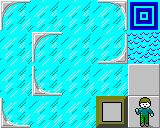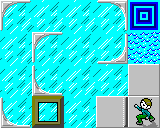Please create an account or Login! Have fun!
Flick: Difference between revisions
Indyindeed (talk | contribs) No edit summary |
m (merge edits i guess??) |
||
| (7 intermediate revisions by 6 users not shown) | |||
| Line 1: | Line 1: | ||
{{otheruses4|the action of moving a [[block]] off an [[acting wall]]|the action of flicking a block using the mouse|Mouse Panel Glitch}} | {{otheruses4|the action of moving a [[block]] off an [[acting wall]]|the action of flicking a block using the mouse|Mouse Panel Glitch}} | ||
To '''flick''' a [[block]] is to push it off of a tile that [[Chip]] cannot enter, i.e. an [[acting wall]]. Normally, blocks are pushed by being displaced: the player enters the block's cell and moves the block out of the way. However, under some circumstances, a block can be pushed out of a cell that the player couldn't have entered in the first place. | |||
Flicking is arguably a [[glitch|bug]] for this reason, but its utility in level design has made it a common feature in official [[level set]]s. | |||
A flick is only possible when the push ''would'' be legal, if the acting wall weren't present. | |||
== Demonstration == | == [[File:Chip S (Lynx).png]] Lynx == | ||
In the [[Lynx ruleset]], flicking is only possible for blocks on real [[blue wall]]s and [[hidden wall]]s. This setup is common in community pack levels after [[CCLP2]], which require that all levels be playable under Lynx rules. An example is [[Bisection]] from [[CCLP4]]. | |||
== [[File:Chip S.png]] MS == | |||
In the [[MS ruleset]], a block may be flicked off of ''any'' acting wall, including normal [[wall]]s, [[socket]]s, real [[blue wall]]s, and [[lock]]s when Chip does not have a matching [[key]]. If a block is on a tile with solid edges, such as an [[ice]] corner or a [[thin wall]], Chip may flick against the walls from the outside to push the block, but the block cannot move ''through'' the walls. For example, a block on a southeast thin wall can be flicked north when Chip is south of the block or flicked west when Chip is east of the block, but cannot be flicked south or east. | |||
If a real block is on a [[clone machine]], pushing the block will clone it in the direction of the push, rather than moving the block off of the clone machine. (What actually happens here is that the block is flicked normally, but the clone machine duplicates anything that moves off of it.) This isn't possible with the clone machines in the original [[Chip's Challenge]], as they all contain [[clone block]]s, which can't be pushed at all. | |||
Prominent levels which require flicking to solve include [[Checkerboard II]] (with closed [[toggle wall]]s) and [[Debug File]] and [[Captured]] (with thin walls). | |||
=== Demonstration === | |||
[[File:Flick.png]] | [[File:Flick.png]] | ||
In this small level, to reach the [[exit]], Chip must move the block to pass the [[water]]. When he tries to move [[Directional notation|-L]], the block is pushed L off the east [[thin wall]], such that this happens: | In this small level, to reach the [[exit]], Chip must move the block to pass the [[water]]. When he tries to move [[Directional notation|-L]], the block is pushed L off the east [[thin wall]], such that this happens: | ||
[[File:Flick part 2.png]] | [[File:Flick part 2.png]] | ||
and the block continues to slide across the [[ice]] until Chip can use it. Note that if the thin wall was facing west, the flick would not work from this direction, as | and the block continues to slide across the [[ice]] until Chip can use it. Note that if the thin wall was facing west, the flick would not work from this direction, as the block would simply stop against the wall. | ||
== Chip's Challenge 2 == | |||
Flicking appears in a more minor and deliberate form in CC2, where a block's movement out of a cell can ''cause'' the cell to become an acting wall and prevent its pusher from following it. This happens with [[recessed wall]]s, [[railroad]]s with appropriate junctions, [[swivel door]]s, and [[turtle]]s. | |||
=== Non-player flicking === | |||
These flicks work exactly the same way for ''any'' of the new CC2 actors that can push blocks: [[yellow tank]]s, [[rover]]s, [[player mirror]]s, and [[ice block|ice]] and [[directional block]]s. The exception is with turtles — those create a splash as they vanish, and splashes only block real players. | |||
== See also == | == See also == | ||
* [[Ram]] | * [[Ram]] | ||
* [[Block slapping]], | * [[Block slapping]], a [[Lynx ruleset|Lynx]]-exclusive move that also allows pushing a block without entering its cell | ||
* [[Spring mining]], a CC2 [[glitch|bug]] with the opposite effect, where pushing a block causes the pusher to move into an acting wall | |||
[[Category:Terminology]] | [[Category:Terminology]] | ||
[[Category:Mechanics]] | [[Category:Mechanics]] | ||
Latest revision as of 18:44, 19 May 2024
To flick a block is to push it off of a tile that Chip cannot enter, i.e. an acting wall. Normally, blocks are pushed by being displaced: the player enters the block's cell and moves the block out of the way. However, under some circumstances, a block can be pushed out of a cell that the player couldn't have entered in the first place.
Flicking is arguably a bug for this reason, but its utility in level design has made it a common feature in official level sets.
A flick is only possible when the push would be legal, if the acting wall weren't present.
 Lynx[edit]
Lynx[edit]
In the Lynx ruleset, flicking is only possible for blocks on real blue walls and hidden walls. This setup is common in community pack levels after CCLP2, which require that all levels be playable under Lynx rules. An example is Bisection from CCLP4.
 MS[edit]
MS[edit]
In the MS ruleset, a block may be flicked off of any acting wall, including normal walls, sockets, real blue walls, and locks when Chip does not have a matching key. If a block is on a tile with solid edges, such as an ice corner or a thin wall, Chip may flick against the walls from the outside to push the block, but the block cannot move through the walls. For example, a block on a southeast thin wall can be flicked north when Chip is south of the block or flicked west when Chip is east of the block, but cannot be flicked south or east.
If a real block is on a clone machine, pushing the block will clone it in the direction of the push, rather than moving the block off of the clone machine. (What actually happens here is that the block is flicked normally, but the clone machine duplicates anything that moves off of it.) This isn't possible with the clone machines in the original Chip's Challenge, as they all contain clone blocks, which can't be pushed at all.
Prominent levels which require flicking to solve include Checkerboard II (with closed toggle walls) and Debug File and Captured (with thin walls).
Demonstration[edit]
In this small level, to reach the exit, Chip must move the block to pass the water. When he tries to move -L, the block is pushed L off the east thin wall, such that this happens:
and the block continues to slide across the ice until Chip can use it. Note that if the thin wall was facing west, the flick would not work from this direction, as the block would simply stop against the wall.
Chip's Challenge 2[edit]
Flicking appears in a more minor and deliberate form in CC2, where a block's movement out of a cell can cause the cell to become an acting wall and prevent its pusher from following it. This happens with recessed walls, railroads with appropriate junctions, swivel doors, and turtles.
Non-player flicking[edit]
These flicks work exactly the same way for any of the new CC2 actors that can push blocks: yellow tanks, rovers, player mirrors, and ice and directional blocks. The exception is with turtles — those create a splash as they vanish, and splashes only block real players.
See also[edit]
- Ram
- Block slapping, a Lynx-exclusive move that also allows pushing a block without entering its cell
- Spring mining, a CC2 bug with the opposite effect, where pushing a block causes the pusher to move into an acting wall

